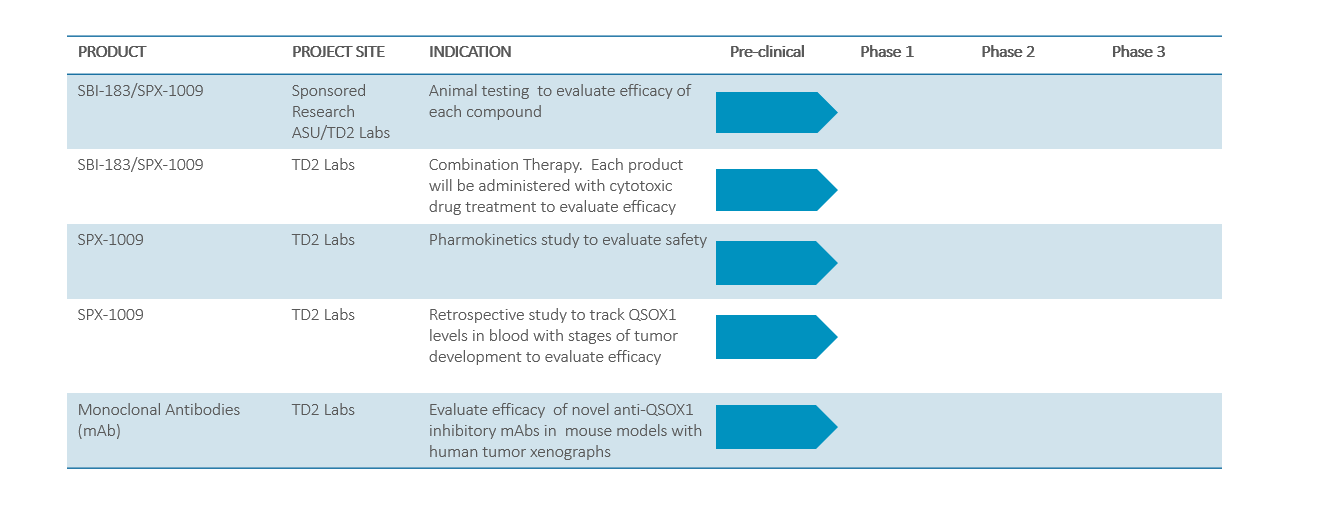THERAPEUTICS
OVERVIEW
Through its research collaborations with various academic and medical facilities, scientists at AXIM are studying a tumor-derived enzyme called “QSOX1” which is a novel cancer target with additional diagnostic potential. Research suggests a chemical compound that inhibits QSOX1 could be an oncology drug and AXIM has discovered SPX-1009 to be such a drug.
THERAPEUTICS PIPELINE
THERAPEUTICS
PIPELINE

background
SCIENCE AND INNOVATION
Metastasis is a multistep process that results in the spread of cancer cells from their primary location to another tissue. Few, if any cancer drugs target metastasis. Since over 90% of cancer deaths are due to metastasis, AXIM is committed to saving lives by developing drugs that interfere with metastasis, few if any drugs directly target a particular step in the metastatic process. Since over 90% of cancer deaths are due to metastasis, attempts to develop drugs that target metastasis are significant.
Tumors surround themselves with an armor of secreted proteins called the Extracellular Matrix. QSOX1 orchestrates the assembly of this protein armor in the Extracellular Matrix. In a dual role, the armor repels anti-cancer drugs while helping the tumor invade from its primary location (e.g. breast) to a metastatic site (e.g. bone). Inhibiting QSOX1 causes “chinks” in the tumor’s armor which allows anti-cancer drugs to i) penetrate into the tumor and ii) halt invasion, a hallmark of metastasis.
background
SCIENCE
AND INNOVATION
Metastasis is a multistep process that results in the spread of cancer cells from their primary location to another tissue. Few, if any cancer drugs target metastasis. Since over 90% of cancer deaths are due to metastasis, AXIM is committed to saving lives by developing drugs that interfere with metastasis, few if any drugs directly target a particular step in the metastatic process. Since over 90% of cancer deaths are due to metastasis, attempts to develop drugs that target metastasis are significant.
Tumors surround themselves with an armor of secreted proteins called the Extracellular Matrix. QSOX1 orchestrates the assembly of this protein armor in the Extracellular Matrix. In a dual role, the armor repels anti-cancer drugs while helping the tumor invade from its primary location (e.g. breast) to a metastatic site (e.g. bone). Inhibiting QSOX1 causes “chinks” in the tumor’s armor which allows anti-cancer drugs to i) penetrate into the tumor and ii) halt invasion, a hallmark of metastasis.
studies
DISCOVERY OF SMALL MOLECULE INHIBITORS
Over 50,000 chemical compounds were screened to identify molecules that inhibit the QSOX1 enzyme.
findings
RESEARCH TO-DATE
QSOX1 enzyme is over-expressed in many tumor types and is associated with a poor prognosis. Genetic knockdown of QSOX1 demonstrated that tumors were less invasive, leading us to screen for, and identify SBI-183, a chemical compound that inhibits QSOX1. SBI-183 is active in vivo and is not toxic even at high doses. The goal of our research is to identify and begin to characterize more potent analogs of SBI-183.
product development
LEAD DRUG CANDIDATE: SPX-1009
AXIM has made significant progress with our lead oncologic drug candidate, SPX-1009 having successfully completed in vitro studies.
As we perform animal studies, we expect SPX-1009 to be suppress metastasis more strongly than SBI-183, as it is a more potent analog in vitro, a key milestone for 2020.